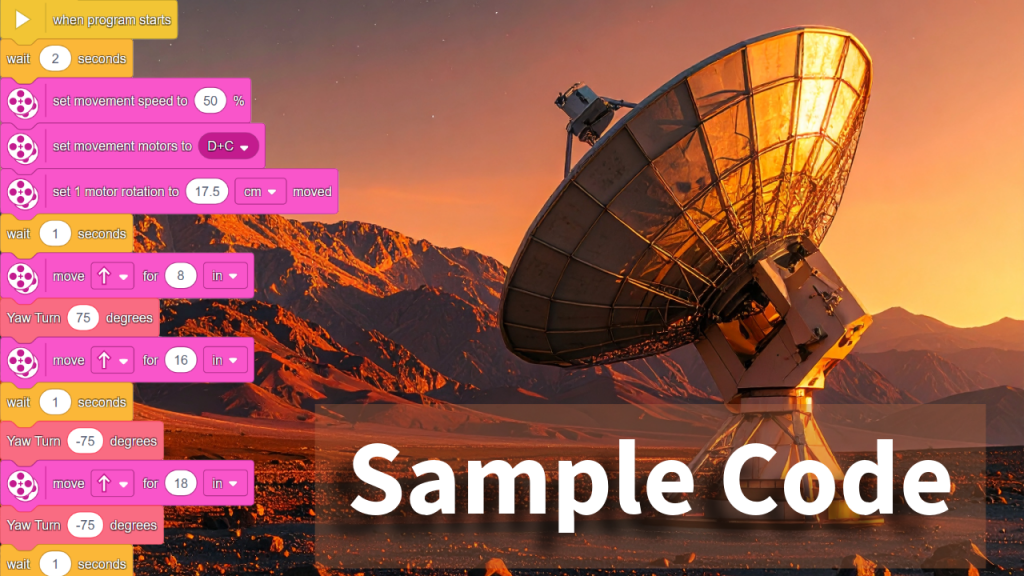Activate Mars Communications Challenge
🧭 Mission Brief
You’re designing and programming a LEGO Spike Prime rover to navigate across a Martian landscape, activate an underground communications satellite, and send a “signal” back to Earth—just like real Mars rovers supporting human exploration.
🎯 Challenge Instructions
Phase 1: The Challenge
- Objective: Drive your rover from base, push the hidden activation button in the ground, deploy the satellite, and broadcast the signal.
- Rules: Start inside base. No touching robot outside base. Mission success when rover triggers satellite and returns.
- BUILD: Build the satellite mission model with directions in the YouTube video.
Phase 2: Brainstorm & Sketch
- Draw a rough prototype: What sensors will you need? How will you push the satellite activation? How will you detect and line up with the button?
Phase 3: Complete the Challenge
Deep Space Communication
Satellite dishes are a type of antenna that uses radio waves to receive or transmit data. On a human mission to Mars, they’d be used to transmit messages between Earth and Mars. Radio waves travel at the speed of light, and because the distance between Earth and Mars is variable, there’s an approximate delay of between four and twenty-four minutes in communication between the planets.
NASA’s Deep Space Network (DSN)
NASA operates a global system of giant antennas called the Deep Space Network. These are located in:
- California (Goldstone)
- Spain (Madrid)
- Australia (Canberra)
They’re spaced around the Earth to allow constant communication with distant spacecraft. The dishes are huge—up to 70 meters wide—so they can catch the tiny signals sent from across the solar system.
Delay in Space Communication
Because radio waves travel at the speed of light, there’s a delay when sending or receiving signals from space.
- A message from Earth to Mars can take anywhere from 4 to 24 minutes one way.
- Voyager 1, the farthest human-made object, takes over 21 hours to send a signal back!
This is why real-time conversations with astronauts on Mars would be impossible.
Laser Communication Is the Future
NASA is testing laser-based communication, which can send more data much faster than traditional radio waves.
- It’s called Deep Space Optical Communication.
- In 2024, a laser from the Psyche spacecraft sent data over 140 million miles at speeds up to 25 megabits per second!
This could be the key to streaming high-quality video from the Moon or Mars one day.
What the Deep Space Network Does
The DSN does more than just listen. It:
- Sends commands to spacecraft
- Tracks their speed and location
- Receives science data
- Helps navigate through space
Without the DSN, we’d lose contact with most space missions!
Why Three Locations?
Each DSN station is 120 degrees apart around the Earth so that at least one of them always has a view of a spacecraft, even as the Earth rotates. This setup allows 24/7 communication with distant probes.
Satellites Closer to Earth Use a Different System
Satellites that orbit Earth don’t use the Deep Space Network. They use a different group of ground stations called the Near Earth Network. These satellites help with weather forecasting, GPS, and communications here on Earth.
The SCaN Program
NASA's Space Communications and Navigation program (SCaN) manages all the networks—both for deep space and near Earth. They’re responsible for upgrading antennas, developing new technology like lasers, and preparing for future Moon and Mars missions.
💡 Build & Code Hints
| Area | Hint |
|---|---|
| Drive Base | Use a sturdy wheel base that can travel straight and align easily. |
| Activation Arm | A lightweight beam or fork that can push just enough—not too much—to trigger the activation mechanism. |
| Sensors | Use Ultrasonic to detect when you’re close to the button; use Color Sensor or distance tracking to keep your path straight. |
| Programming | Use loops for straight motion, conditional waits to stop at precise points, and fine motor power settings for controlled pushes. |
📐 Step-by-Step Measurements & Angle Calculation
Step 1: Measure distance from base to satellite button in your setup (e.g. 40 cm).
Step 2: Calculate turning angles if you need to approach the button from the side:
- If the approach path veers, use geometry/pacing to compute heading angles.
Step 3: Sample Code

Encourage students to fill in their exact measurements and calculated angles.
📺 Final Video Solution
Once students have built and programmed their rovers, they can watch the final completed mission. The video demonstrates a working solution—from navigation to block alignment to satellite activation and return to base.
“Mission Walkthrough” — Compare your approach with our at-home version
✅ Evaluation & Reflection
Self-Assessment:
- Did your robot trigger the satellite reliably?
- Was your code precise and consistent?
- Did you work collaboratively and solve issues creatively?
Badge Levels:
- Bronze: Activation attempt but fails
- Silver: Satellite deploys but unstable
- Gold: Satellite upright and stable
- Platinum: Adds extra features beyond requirements
🧰 Lesson Resources
- Printable measurement & pseudocode worksheet
- Extension ideas: vary button placement, sensor combos, timing constraints
